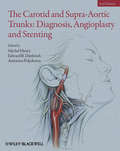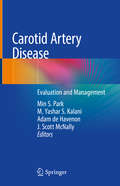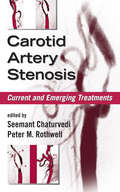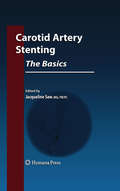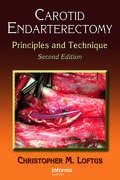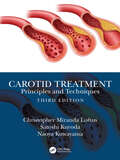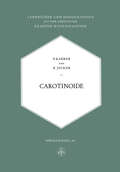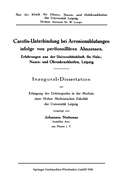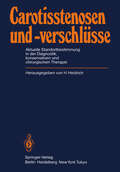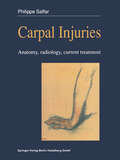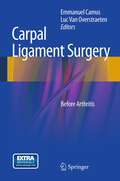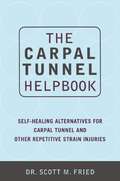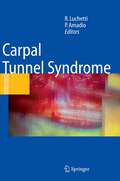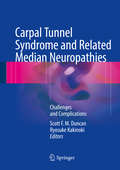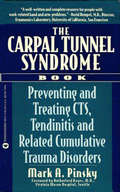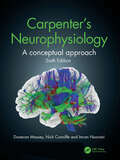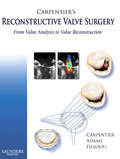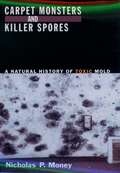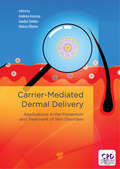- Table View
- List View
The Carotid and Supra-Aortic Trunks: Diagnosis, Angioplasty and Stenting
by Michel Henry Edward B. Diethrich Antonios PolydorouCarotid Angioplasty and Stenting (CAS) is a new approach to treat a carotid stenosis. This new book provides interventional cardiologists, both as beginners or fully experienced, with a reference on all aspects of angioplasty and stenting of the carotid and supra-aortic trunks. Focusing on both the entire range of angioplasty and stenting treatment options for the surgeon treating patients on the operating table, and the range of radiological techniques used for the cardiologist to diagnose carotid artery stenosis (CAS) and associated conditions, this important book describes the best indications, the different techniques, the results, and also the limitations of CAS based on randomized studies and particularly the last published data (CREST study). Suitable for both novice and experienced interventionalists, it also addresses diagnosis of a carotid stenosis and complications from CAS and how to manage them.
The Carotid and Supra-Aortic Trunks: Diagnosis, Angioplasty and Stenting
by Michel Henry Edward B. Diethrich Antonios PolydorouCarotid Angioplasty and Stenting (CAS) is a new approach to treat a carotid stenosis. This new book provides interventional cardiologists, both as beginners or fully experienced, with a reference on all aspects of angioplasty and stenting of the carotid and supra-aortic trunks. Focusing on both the entire range of angioplasty and stenting treatment options for the surgeon treating patients on the operating table, and the range of radiological techniques used for the cardiologist to diagnose carotid artery stenosis (CAS) and associated conditions, this important book describes the best indications, the different techniques, the results, and also the limitations of CAS based on randomized studies and particularly the last published data (CREST study). Suitable for both novice and experienced interventionalists, it also addresses diagnosis of a carotid stenosis and complications from CAS and how to manage them.
Carotid Artery Disease: Evaluation and Management
by Min S. Park M. Yashar S. Kalani Adam De Havenon J. Scott McNallyThis truly comprehensive title addresses all aspects of the evaluation and management of carotid artery disease. The extracranial carotid artery is an area of confluence for both medical and surgical specialists. Given its unique position and function in the body, disease states that involve the carotid artery require a unique approach to ensure the best outcomes for patients. Developed by a multidisciplinary team of thought leaders from across medical, surgical, and radiological disciplines, Carotid Artery Disease: Evaluation and Management provides a diverse resource where readers can find presentation, evaluation, and management recommendations for any process involving the extracranial carotid artery, be it related to atherosclerotic, traumatic, inflammatory, or even oncologic disease. Indeed this title is a unique offering in that one can find traditional, and even exclusively medical, conditions within the same binding as surgical or interventional ones. Typically, access to this type of information requires the purchase of multiple different texts, but this complete title distills the evaluation and management of carotid artery disease into a one-of-a-kind, practical, accessible reference. A much-needed and invaluable contribution to the clinical literature, Carotid Artery Disease: Evaluation and Management will be of great interest to anyone early in his or her career and needing an introduction to the field, as well as seasoned clinicians in need of state-of-the-art, refresher information.
Carotid Artery Stenosis: Current and Emerging Treatments (Neurological Disease And Therapy Ser.)
by Seemant Chaturvedi Peter M. RothwellProviding a thorough overview of rapid developments in medical therapy, surgery, and angioplasty, this reference provides a complete review of carotid artery stenosis treatment, as well as a clear overview of carotid surgery and stenting. Offering chapters by seasoned authorities on epidemiology, imaging with ultrasound and angiography, cholesterol
Carotid Artery Stenosis: Current and Emerging Treatments
by Seemant Chaturvedi Peter M. RothwellProviding a thorough overview of rapid developments in medical therapy, surgery, and angioplasty, this reference provides a complete review of carotid artery stenosis treatment, as well as a clear overview of carotid surgery and stenting. Offering chapters by seasoned authorities on epidemiology, imaging with ultrasound and angiography, cholesterol
Carotid Artery Stenting: The Basics (Contemporary Cardiology)
by Jacqueline SawOver the past three decades, carotid artery stenting has evolved to become a promising and viable alternative to carotid endarterectomy, especially for patients deemed to have high surgical risks. In Carotid Artery Stenting: The Basics, Jacqueline Saw and a panel of international experts on carotid artery stenting discuss in depth the details of all contemporary aspects of carotid stenting, while reviewing supporting studies, guidelines, technical perspectives, and peri-procedural management. This textbook serves as a learning resource on the multifaceted management of patients with carotid artery stenosis, with the key focus on extracranial carotid artery stenting. Additional sections detail the specifics of setting up and maintaining a laboratory and discuss the preparation of the carotid artery stenting procedure from both the patient and operator’s perspective. Authoritative and highly practical, Carotid Artery Stenting: The Basics is an accessible guide and valuable resource for today’s cardiologists, radiologists, and vascular surgeons.
Carotid Endarterectomy: Principles and Technique
by Christopher M. LoftusWith 50% new photos and a vast selection of current clinical cases, this source supplies an abundance of color images and provides illustrative sections on the patch graft technique, recurrent disease, complex and unusual carotid surgeries, and discussions of carotid complications and their remedies. As in the First Edition, color photographs are a
Carotid Treatment: Principles and Techniques
by Christopher Miranda Loftus Satoshi Kuroda Naoya KuwayamaScientific and epidemiologic progress surrounding carotid artery surgery continues to evolve, and for the better, for both surgeons and patients. Carotid surgery, performed by skilled surgeons with quantifiable results, prevents stroke in asymptomatic and symptomatic patients. The challenge is to continually refine the techniques to ensure the greatest possible margins of safety, and to educate surgeons around the world to ensure uniform standards of care. Carotid artery stenting, again performed by skilled practitioners with quantifiable results, has developed as a viable alternative to CEA in chosen cases. Carotid Treatment, Third Edition represents the current state of the art in carotid treatment. Coverage includes a comprehensive and practical new chapter on carotid stenting, increased coverage of radiography, and highly illustrated surgical technique case examples reflecting international practice. Throughout the book numerous case examples, and interesting examples of anatomical variants are illustrated and explained. An expanded section on complications further increases the value of this resource for all practitioners. Highly illustrated text to aid understanding of best practice in carotid treatment Reflects international best practice Useful in clinical practice and to improve patient care Neurosurgeons, Vascular surgeons, and Neuro-Interventionalists will benefit from the experience and wisdom shared in the third edition of this acclaimed text.
Carotid Treatment: Principles and Techniques
by Christopher Miranda Loftus Satoshi Kuroda Naoya KuwayamaScientific and epidemiologic progress surrounding carotid artery surgery continues to evolve, and for the better, for both surgeons and patients. Carotid surgery, performed by skilled surgeons with quantifiable results, prevents stroke in asymptomatic and symptomatic patients. The challenge is to continually refine the techniques to ensure the greatest possible margins of safety, and to educate surgeons around the world to ensure uniform standards of care. Carotid artery stenting, again performed by skilled practitioners with quantifiable results, has developed as a viable alternative to CEA in chosen cases. Carotid Treatment, Third Edition represents the current state of the art in carotid treatment. Coverage includes a comprehensive and practical new chapter on carotid stenting, increased coverage of radiography, and highly illustrated surgical technique case examples reflecting international practice. Throughout the book numerous case examples, and interesting examples of anatomical variants are illustrated and explained. An expanded section on complications further increases the value of this resource for all practitioners. Highly illustrated text to aid understanding of best practice in carotid treatment Reflects international best practice Useful in clinical practice and to improve patient care Neurosurgeons, Vascular surgeons, and Neuro-Interventionalists will benefit from the experience and wisdom shared in the third edition of this acclaimed text.
Carotinoide (Lehrbücher und Monographien aus dem Gebiete der exakten Wissenschaften #17 )
by Paul Karrer Ernst M. JuckerCarotis-Unterbindung bei Arrosionsblutungen infolge von Peritonsillären Abszessen: Erfahrungen aus der Universitätsklinik für Hals-, Nasen- und Ohrenkrankheiten, Leipzig
by Johannes Stabenau Universitätsklinik f. Hals-, Nasen- u. OhrenkrankheitenDieser Buchtitel ist Teil des Digitalisierungsprojekts Springer Book Archives mit Publikationen, die seit den Anfängen des Verlags von 1842 erschienen sind. Der Verlag stellt mit diesem Archiv Quellen für die historische wie auch die disziplingeschichtliche Forschung zur Verfügung, die jeweils im historischen Kontext betrachtet werden müssen. Dieser Titel erschien in der Zeit vor 1945 und wird daher in seiner zeittypischen politisch-ideologischen Ausrichtung vom Verlag nicht beworben.
Carotisstenosen und -verschlüsse: Aktuelle Standortbestimmung in der Diagnostik, konservativen und chirurgischen Therapie
by H. Heidrich2. Angiologisches Symposium der Inneren Abteilung des Franziskus-Krankenhauses Berlin in Zusammenarbeit mit der Deutschen Gesellschaft für Angiologie, Berlin 9.-11. März 1983
Carpal injuries: Anatomy, radiology, current treatment
by Philippe SaffarClassification of the carpal injuries helps us to understand the relationship between them. The growing interest in this field has been advanced by recent imaging techniques. Therapeutic advice and treatment are still not completely defined, even by the most renowned specialists. There is still room for new concepts.
Carpal Instability: The Comprehensive Case-Based Approach
by Jeffrey YaoThis case-based guide is the most comprehensive, up-to-date work focusing on the topic of carpal instability. This work presents all aspects of the conditions including anatomy, physical examination, classification, kinematics, and nonsurgical and surgical methods of management. A wide variety of topics are presented, such as dynamic, static acute, and chronic reducible scapholunate ligament injury, subacute lunotriquetral ligament injury, perilunate injury, SLAC wrist, and more. For each topic, the traditional options as well as the most cutting-edge treatment modalities are discussed in detail, illustrated with numerous clinical and intraoperative photos. Written by a world-class international group of authors comprised of the most widely known experts in the field of carpal instability from around the world, this practical guide will serve as the authoritative resource for young and senior surgeons alike.
Carpal Ligament Surgery: Before Arthritis
by Emmanuel Camus and Luc Van OverstraetenIt has by now been established that carpal ligamentary lesions may lead to instability and ultimately to carpal arthritis. However, the variety of anatomopathological classifications and the multiplicity of surgical repair techniques reflect the difficulty of grasping this ligamentary pathology.Clinical analysis and traditional investigation techniques must successfully address the complexity of the wrist, which is largely due to the number of synchronized bones involved in every movement of the hand. The clinical analysis of the wrist is insufficient to precisely measure the mobility of each carpal bone, making paraclinical examinations also significant for clinical diagnosis. The tools available today range from X-rays to arthroscopy, including arthroCTscans and soon MRI. As for repair techniques, their diversity must not hide the fact that a biomechanical and physiological principle is involved and must be identified. This book presents the findings of an expert group in the field of wrist pathology. It seeks to analyze, understand, explain and make comprehensible, if not obvious, the reflections that each practitioner should employ during the diagnosis and treatment of carpal ligamentary lesions. The focus is consciously not on degenerative carpal pathology, which usually enjoys more visibility. We hope that readers will benefit from the fact that fragmented pieces of knowledge are gathered in a single work, that they will find in this initial synthesis an inspiration to rethink a difficult and sometimes thankless surgery and to further the surgical advances of the 21st century.
The Carpal Tunnel Helpbook: Self-healing Alternatives For Carpal Tunnel And Other Repetitive Strain Injuries
by Scott FriedThere are more than 500,000 carpal tunnel surgeries done annually in the United States but approximately 30 percent of these patients will be no better as a result. The truth is, most physicians are too quick to consider surgery as the first line of defense against carpal tunnel and other repetitive-strain injuries. In this comprehensive guide to recognizing and treating these debilitating conditions, Dr. Scott Fried takes a strong position against surgery and offers self-healing alternatives that have better results. From understanding the signs and symptoms at an early stage to modifying work and lifestyle; from proven alternative therapies and helpful medications to nutrition and exercise, The Carpal Tunnel Helpbook provides authoritative advice and practical, up-to-date information to spare many patients the ordeal of surgery to treat their injuries.
Carpal Tunnel Syndrome
by Riccardo Luchetti Peter AmadioCovers all aspects of CTS: diagnosis - management - outcome assessment Abundantly illustrated
Carpal Tunnel Syndrome and Related Median Neuropathies: Challenges and Complications
by Scott F. Duncan Ryosuke KakinokiPractical and user-friendly, this text provides the orthopedic and hand surgeon with all the essential information for diagnosing and treating carpal tunnel syndrome (CTS) and other median neuropathies of the hand and wrist, with special emphasis on challenges and complications. Organized to allow for easy searching of specific subject matter, opening chapters discuss anatomy of the median nerve, history and pathophysiology of CTS, clinical presentation and diagnosis, including imaging, and severity scoring. Presentation of various treatment strategies follows, both non-operative and surgical, including open and endoscopic techniques and revision surgery, incomplete release, transection, use of the reverse radial forearm flap, vein wrap, synovial wrap, and microneurolysis. Other median neuropathies are discussed as well, including neuromas and stimulation for chronic median nerve pain.Generously illustrated, Carpal Tunnel Syndrome and Related Median Neuropathies is a valuable resource for orthopedic and hand surgeons on the evaluation and treatment of complications and complexities arising from carpal tunnel syndrome and surgery.
The Carpal Tunnel Syndrome Book: Preventing and Treating CTS
by Mark A. PinskyExplains how Carpal Tunnel Syndrome--nerve damage in the wrists from performing repetitive tasks--is developed; how computer users, assembly-line workers, and others can reduce the risk of injury; how to recognize symptoms; and more.
Carpenter's Neurophysiology: A Conceptual Approach
by Dunecan Massey Nick Cunniffe Imran NooraniNeurophysiology: A Conceptual Approach offers a refreshing alternative to ‘learning by rote’. Under new authorship, the sixth edition preserves the legacy of the original author, the late Roger Carpenter, retaining the concise approach and readable style so central to its predecessors. Integrating the disciplines of neurology and neuroscience with an emphasis on principles and functional concepts, this comprehensive textbook covers the entire subject of neurophysiology, from the conduction of nerve impulses to the higher functions of the brain, within a single accessible volume. Key Features: Everything the student of medicine or physiology needs to understand neurophysiology. Blends successfully the principles of neuroscience with clinical manifestations in line with modern undergraduate curriculums. Revised and updated, with a particular focus on proprioception, skin sense and hearing, including developments in cochlear implants, and functional MRI Over 500 illustrations, accompanied by full figure legends, also available as a download for use in presentations. Choice of PB with bundled ebook, durable HB or ebook only for complete flexibility Full of explanatory colour diagrams, the book remains an unrivalled ‘one-stop shop’ for students of medicine, physiology and applied physiology, neurophysiology, neuroscience, and other bioscience disciplines seeking an integrated introduction to the challenging disciplines of neuroscience and neurology.
Carpenter's Neurophysiology: A Conceptual Approach
by Dunecan Massey Nick Cunniffe Imran NooraniNeurophysiology: A Conceptual Approach offers a refreshing alternative to ‘learning by rote’. Under new authorship, the sixth edition preserves the legacy of the original author, the late Roger Carpenter, retaining the concise approach and readable style so central to its predecessors. Integrating the disciplines of neurology and neuroscience with an emphasis on principles and functional concepts, this comprehensive textbook covers the entire subject of neurophysiology, from the conduction of nerve impulses to the higher functions of the brain, within a single accessible volume. Key Features: Everything the student of medicine or physiology needs to understand neurophysiology. Blends successfully the principles of neuroscience with clinical manifestations in line with modern undergraduate curriculums. Revised and updated, with a particular focus on proprioception, skin sense and hearing, including developments in cochlear implants, and functional MRI Over 500 illustrations, accompanied by full figure legends, also available as a download for use in presentations. Choice of PB with bundled ebook, durable HB or ebook only for complete flexibility Full of explanatory colour diagrams, the book remains an unrivalled ‘one-stop shop’ for students of medicine, physiology and applied physiology, neurophysiology, neuroscience, and other bioscience disciplines seeking an integrated introduction to the challenging disciplines of neuroscience and neurology.
Carpentier's Reconstructive Valve Surgery E-Book
by Alain Carpentier David H. Adams Farzan FilsoufiCarpentier’s Reconstructive Valve Surgery presents you with authoritative guidance on reconstructive techniques for degenerative mitral valve disease. Alain Carpentier, MD, PhD—who pioneered the field—David H. Adams, MD; and Farzan Filsoufi, MD provide step-by-step instructions for each procedure and over 200 detailed anatomic drawings so that you can effectively apply the techniques of a master.Apply the techniques and procedures of Dr. Alain Carpentier—pioneer of mitral valve reconstruction—to your practice. View more than 200 detailed anatomic drawings that depict reconstruction procedures clearly. Master each procedure using step-by-step instructions and a consistent chapter format. Grasp the nuances of procedures thanks to "tips from the Master" and a section of questions and answers. Tap into the knowledge and experience of leaders in the field of mitral valve repair and reconstruction.
Carpet Monsters and Killer Spores: A Natural History of Toxic Mold
by Nicholas P. MoneyMolds are everywhere: we inhale their microscopic spores from birth to death. But when an investigation in Ohio revealed that babies suffering from a serious lung illness had been exposed to a toxic black mold in their homes, millions of Americans became nervous about patches of mold in their own basements and bathrooms. Before long, lawsuits were filed by the residents of mold-contaminated homes in every state. By failing to address water damage, building contractors, plumbers, and insurance agents were held liable for exposing families to an unprecedented microbiological hazard. The mold crisis soon developed into a fully-fledged media circus. In Carpet Monsters and Killer Spores, Nicholas Money explores the science behind the headlines and courtroom dramas, and profiles the toxin-producing mold that is a common inhabitant of water-damaged buildings. Nicholas Money tells the most important mycological story since potato blight, with his inimitable style of scientific clarity and dark humor.
Carpet Monsters and Killer Spores: A Natural History of Toxic Mold
by Nicholas P. MoneyMolds are everywhere: we inhale their microscopic spores from birth to death. But when an investigation in Ohio revealed that babies suffering from a serious lung illness had been exposed to a toxic black mold in their homes, millions of Americans became nervous about patches of mold in their own basements and bathrooms. Before long, lawsuits were filed by the residents of mold-contaminated homes in every state. By failing to address water damage, building contractors, plumbers, and insurance agents were held liable for exposing families to an unprecedented microbiological hazard. The mold crisis soon developed into a fully-fledged media circus. In Carpet Monsters and Killer Spores, Nicholas Money explores the science behind the headlines and courtroom dramas, and profiles the toxin-producing mold that is a common inhabitant of water-damaged buildings. Nicholas Money tells the most important mycological story since potato blight, with his inimitable style of scientific clarity and dark humor.
Carrier-Mediated Dermal Delivery: Applications in the Prevention and Treatment of Skin Disorders
by Andreia Ascenso Helena Ribeiro Sandra SimoesThis book presents new approaches for skin aging and photocarcinogenesis and topical formulations based on nanocarrier systems for skin disorders. It discusses cosmeceuticals, laser, photodynamic therapy, and melatonin-based treatments as important strategies for photoaging management. Photodynamic therapy and melatonin can be used in the photocarcinogenesis context, too. Therefore, the inclusion of this strong antioxidant in sunscreen products could be a promising approach. The book discusses topical formulations, including emulsions (conventional formulations and emulsions stabilized by solid particles), nail films, and nanocarriers used for the delivery of actives in various skin and nail diseases such as acne, psoriasis, atopic dermatitis, fungal diseases, leishmaniasis, and skin cancer. Finally, several nanocarriers are introduced, such as lipid vesicles (ranging from the first-generation conventional liposomes to the more recent deformable vesicles), liquid crystalline nanodispersions, gelatin, and solid lipid nanoparticles. Their composition, formulation, characterization, and topical applications are also discussed. Although this is a broad topic, the most important (nano)pharmaceutical formulations are presented in the book.
